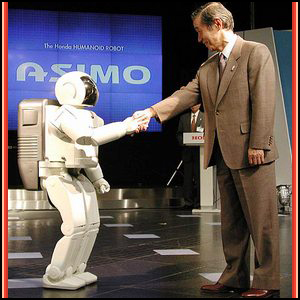Future of Robotics
As time progresses, technology advances at an alarming rate.
The world of robotics included, has seen some improvements in the base work of
many different aspects. Assisting with disabilities remains a major goal of many
people within the robotic technology world. One must also keep in mind that many
robots that one would not consider “robots” are in place today for convenience and
for disabilities. Look at voice recognition software for instance, it is not a robot
but its technology can be put into a robot that can automatically lock your doors or
turn off a coffee pot. On the other hand, a large part of the engineers and designers
are moving away from disability specific robots and moving towards one humanoid robot,
that can act as a personal assistant filling the role of all other robotic designed
now while still offering aid for a large variety of people. Starting in 1986, Honda
started building and designing humanoid robots. With these robots, many challenges
still being solved must be overcome in order for this product to be useful in fully
helping people. Mimicking human behavior and the human body has not come easily.
Walking requires more than moving one foot forward followed by the next foot. It
requires countless of other joint movement and exact alignment to keep balance.
Engineers have spent years working on improving these methods in order to come up
with a robot that can walk, move freely and keep its balance. Now ASIMO, the robot by
Honda can dance, walk, walk and turn without falling, go up stairs, do all these simple
tasks that one day prove to be a robot which will offer another set of ears and eyes
to a person in need of assistance. Other corporation such as Toyota is also interested
in further developing a humanoid robot to assist the elderly. These robots will also
server other purposes besides aiding people with disabilities. They might also be able
to be used in search and rescue missions or other tasks that are harmful to humans
such as fighting fires. The overall future of this technology encompasses not only
the purpose of helping others but also the generalized purpose of doing tasks we as
humans cannot do alone.

What needs to be done
In order to reach the technology of the future numerous challenges must be overcome to enhance
the possibility to aid disabilities. Robots, unlike human do not have all the basic skills, which
are automatic for people. The entire architecture, every single aspect must be taken into account
when designing anything. A humanoid robot would be the result of years of research as seen now but
improvements never cease. Whether it be from improving battery life, to movement, to lighter metal,
all these things with time and new processes will change. Perhaps the most difficult technology to
improve on would be the human like response, in other words, the brain. At the Massachusetts Institute
of Technology, they have been developing a robot, most famously by the name of Cog that is capable
of learning. It may not be calculus but using advancements in artificial intelligence, Cog uses
simulations to learn tasks such as differentiating between colors. These technological skills are
critical in the success of future humanoid robots and would be considered as one of the top priorities.
As scientists, dedication to research and time spent testing new prototypes would be the best way to
improve now.
|